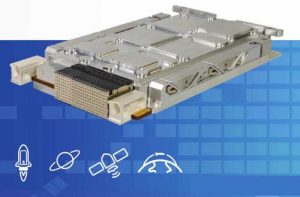Mercury Systems With Second Gen of Space-Qualified TRRUST-Stor VPX RT Radiation-Tolerant SSD
Up to 940GB, integrated into 6U SpaceVPX form factor, improved error correction algorithms for long-term data integrity in radiation-intense environments
This is a Press Release edited by StorageNewsletter.com on April 10, 2019 at 2:28 pmMercury Systems, Inc. announced the start of customer engagements for its second generation of the TRRUST-Stor VPX RT family of radiation-tolerant SSD featuring up to 940GB user capacity in a 6U SpaceVPX form factor.
6U TRRUST-Stor VPX RT
This device delivers enhanced versatility with improved ECC and both Serial RapidIO and PCIe host interfaces. As the first space-qualified storage devices leveraging the SpaceVPX standard for agile interoperability, the TRRUST-Stor VPX RT family enables accelerated system design directly addressing the demand for low Earth orbit (LEO) satellites and mission critical systems operating in radiation-intense environments.
In terrestrial environments, the NAND flash memory devices used in a traditional SSD device are prone to data corruption without the use of ECC. In radiation-exposed environments, data corruption is accelerated due to the occurrence of single-event effects (SEE) and total ionizing dose (TID) degradation which negatively impact the functionality of the NAND flash memory used in the device.
3U TRRUST-Stor VPX RT
To counter these damaging effects, the company has improved the ECC performance of the original 3U TRRUST-Stor VPX RT device. With 30% more error corrections built-in, the 6U device integrates high-reliability defect mitigation thereby enabling normal read and write operations in the presence of harmful ionizing radiation. Additionally, these SSD features redundant NAND flash to improve long-term reliability and data integrity.
Recognizing that no two missions have identical requirements, the firm’s new device is built on a platform to readily enable cost vs. performance customization. These product variants can be realized where the ECC, spare device count, user capacity and power consumption are optimized for specific programs. The scalable manufacturing and test resources of the company’s Advanced Microelectronics Centers assure a transition of custom product variants through volume production.
“With the successful adoption of our 3U TRRUST-Stor VPX RT SSD for multiple LEO satellite applications, we are proud to introduce the next generation of commercial SSD technology optimized for space and other radiation-intense environments while sustaining greater than 1GB/s data transfer rates,” said Iain Mackie, VP and GM, microelectronics secure solutions group, Mercury. “Whether our valued customers are designing a single satellite, a constellation of satellites or a terrestrial computing system exposed to radiation, Mercury is committed to reducing our customers’ program risk by leveraging the scalable manufacturing and test capabilities of our Advanced Microelectronics Centers.“
Today’s product announcement exemplifies the company’s commitment to expanding its space-qualified product portfolio for defense prime contractors and commercial satellite manufacturers. As a testament to this commitment, the company is also developing new architectures to provide feature-rich space-grade SSD devices of up to 32TB user capacity for space radar applications. The firm also offers a portfolio of space-qualified RF and microwave solutions that have been trusted on every mission to Mars without device failure.
The company designs and manufactures its entire portfolio of space-qualified SSD devices in a Defense Microelectronics Activity (DMEA)-accredited facility for design, packaging, test and broker services. The firm’s dedication to excellence in all aspects of industrial security has been recognized by the Defense Security Service (DSS) with Superior ratings of several of its sites, including this DMEA-accredited facility.
The company is accepting orders for TRRUST-Stor VPX RT 6U flight units for delivery in 4Q19. Additionally, it welcomes inquiries from customers whose system designs may benefit from a 3U form factor variant of the second generation product, which is currently under development.















 Subscribe to our free daily newsletter
Subscribe to our free daily newsletter


